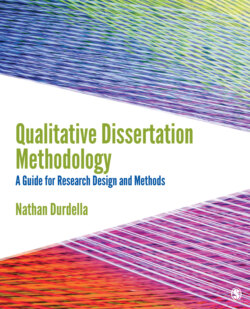Читать книгу Qualitative Dissertation Methodology - Nathan Durdella - Страница 81
На сайте Литреса книга снята с продажи.
Key Points in Dissertation Methodology Development
ОглавлениеFirst year and second years: coursework, faculty advising, topic selection, literature search and review, research framework development
Second and third years: coursework, faculty or dissertation advising, dissertation pilot or proposal development, IRB protocol draft and submission
Third year and beyond: coursework, dissertation advising, and dissertation proposal development and hearing, fieldwork and data collection, data analysis and write up, and final dissertation development and defense
You can see from this example, the student’s research purpose evolves from a more general approach to examining academic entrepreneurialism to an exploration of the factors associated with the patterns of entrepreneurial community college faculty—using a grounded theory case study design.
In my work with doctoral students—including dissertation advisees—the developmental changes that mark dissertation research frameworks tend to happen alongside coursework and faculty advising in the first and second years of a program. During this time, students usually form initial dissertation topics and early versions of research purpose and questions. Once assigned a dissertation advisor and through a significant portion of coursework in the second and third years of a program, dissertation work tends to focus on dissertation pilot research and proposal development, where the study’s background and context come alive and inform work in the methodological framework. In the third program year and beyond, the combination of any outstanding classes needed to fulfill degree requirements, dissertation advising, and dissertation proposal development and hearing, fieldwork and data collection, data analysis and write up, and final dissertation development shape the sections of the methodology chapter.
The curricular and research experiences and ritualistic events are generally associated with substantive growth as student scholars—and changes in dissertation methodology reflect this relationship. In the following example, you can see how the evolution of research questions parallels the students’ progression through the program:
Years 1–2: How is information about academic dishonesty communicated to students? What formal discussion is taking place? What efforts can be taken to address this issue? (Bluestein, September 2010, p. 2).
Years 2–3: How does the faculty–student relationship cultivate shared norms with respect to academic dishonesty? What factors of the faculty–student relationship mitigate academic dishonesty? (Bluestein, December 2010, p. 2).
Years 3+: What are the effects of the student–faculty interaction on student behavior related to academic honesty? What factors of the student–faculty relationship facilitate student academic dishonesty? (Bluestein, 2012, p. 7).
Here, you can see the transition from more general research questions to a set of two questions directly related to the phenomenon under investigation and linked to a qualitative research tradition (in this case, grounded theory). In a final example, you can see the development of a qualitative research tradition over the course of a 3-year doctoral program in educational leadership:
Years 1–2: I am seeking to know the nature of the knowledge that will be discovered through the portraiture methodology. (Bailey, October 2010, p. 1).
Years 2–3: Portraiture as a methodological framework seeks to understand systems of power and differencing aspects of culture by exploring diverse voices. (Bailey, December 2010, p. 4).
Years 3+: Coupled with validation theory, portraiture methodology positions this study to illuminate the voices from underserved and minority populations. (Bailey, 2014, p. 8).
In this case, the student moves from an initial statement on the use of portraiture methodology to a description of the research tradition in relation to the exploration of underserved student populations.
Table 2.4
